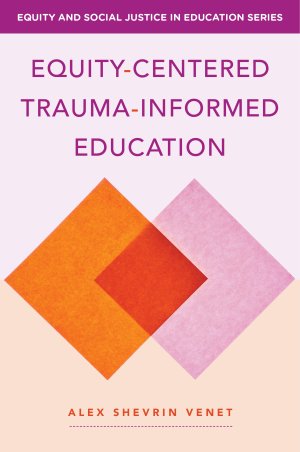Setting Priorities in Trauma-Informed Education
In this excerpt from her new book, Alex Shevrin Venet explains how she makes decisions that support students who have experienced trauma.
Your content has been saved!
Go to My Saved Content.For equity-centered trauma-informed practices to be a universal approach, we need to infuse trauma and equity awareness into our decision making. This is perhaps the most literal sense of being trauma-informed: when our thought process is informed by trauma. To make things easier for myself when I’m planning and making decisions, I boiled down much of what I’ve learned about trauma into four priorities:
- Predictability
- Flexibility
- Empowerment
- Connection
Each of those priorities is based on a key theme of understanding about how trauma impacts children and their learning. If I prioritize these four areas, I’m infusing my trauma awareness into my planning. Focusing on these priorities can help make learning more equitable for trauma-affected students, but it’s also good practice for all students.
Predictability
Trauma creates a profound sense of unpredictability. Traumatic events occur in unpredictable ways. Once impacted by trauma, children become highly attuned to cues of danger, and their stress-response systems are activated more easily. These cues may trigger the stress-response system unconsciously, which means that trauma-affected children may not feel that their own moods or emotions are predictable, let alone the outside world. Living with a sense of chaos can worsen children’s perceptions of the world being an unsafe place.

Being predictable doesn’t mean being rigid. We need to consider the interplay of predictability and flexibility for any structures or routines we build. Despite the rigid schedule of many schools, they can be an unpredictable place for students. Some of this has to do with inconsistencies between teaching staff and students experiencing different rules, different environments, and different responses to their behavior in each room of a school. Some of it is simply due to the unpredictable nature of many humans gathering together in the same place each day.
One of the universal supports we can offer students to make school feel more predictable is getting on the same page as adults. To provide predictable responses to students, we also need to make sure that as adults we stay regulated and do not become emotionally volatile in the face of student challenges. Predictable responses from adults help kids stay safe.
Another aspect of predictability is in anticipating the moments that feel unsettled and planning to give time and space to settle. Think about your students coming back from recess or lunch or returning to class after an assembly. You have two choices at that moment: ignore the fact that most students will feel unsettled, attempt to get them straight to work, and then feel frustrated when they aren’t on-task immediately; or anticipate that people’s bodies and minds feel unsettled when moving from task to task or activity to activity and predictably build in a settling routine before moving to academic tasks. A settling routine could be as simple as a few moments for students to chit-chat, get seated, drink water, and use the bathroom. It could be more structured, with stretching, movement, or breathing led by the teacher. Either way, planning in routines that address the needs of our minds and bodies can help foster a sense of predictability and calm.
I was once invited to a school where teachers asked me if some of their students’ challenging behaviors could be related to underlying trauma. In my visit at the school, I observed many classrooms throughout several days. I saw students as young as second grade working for long stretches of time on individual laptops; large groups of students asked to sit still, elbow to elbow on a bench, and listen for 20 minutes to verbal instructions; one short recess in the middle of the day with very few movement breaks; no group projects; and very little hands-on learning. Here’s what I made of this observation: Could some of the challenging behaviors described by teachers be attributable to trauma? Sure. But the same behaviors were mostly perfectly developmentally appropriate behavior for children who are asked to keep their bodies still and quiet for hours on end.
Concrete ways to foster predictability:
- Create flexible routines for the school day. Thoughtfully schedule pull-out services or groups so that students don’t deviate too much from the overall class schedule for the day.
- Plan in time to settle after transitions and for students (and teachers) to move their bodies and meet basic needs. “Bell-to-bell instruction” with three minutes between classes is inhumane.
- Teachers are a great source of predictability when we can remain grounded and regulated throughout a school day. Teachers should consider what coping and mindfulness strategies they can use during stressful moments, and administrators should focus on creating sustainable working conditions for all school staff.
Flexibility
Trauma impacts each person differently. Trauma can also impact the same person differently from day to day. Because we can end up extra-sensitive to the cues in our environment and go into survival mode at a moment’s notice, people with trauma need flexibility so that they can feel their feelings and not feel rushed and out of control because they’re trying to fit into someone else’s schedule.
One size never fits all in education, and that’s particularly true when we think about mental health. When we feel pressured to fit into a rigid schedule and meet other people’s expectations with no sensitivity for our emotions, we can end up dissociating and shutting down our ability to stay in tune with our minds and bodies. Dissociation is a stress response in which we feel distant from the current moment. It’s the feeling of watching yourself from outside of your own body, like what’s happening isn’t actually real. When we ask students to rush, to ignore their feelings so they can “be positive” in class, in essence we are asking them to dissociate. Members of the school community shouldn’t need to compartmentalize in order to be a valued part of the school.
Instead, we should have opportunities to check in and notice what we need. We should be able to do things in different ways because the learning goal is more important than the standardized process of getting there. The phrase I encourage teachers to remember is “there are different paths up the mountain.” We might all be hiking to the same place, but some of us will need more breaks or to walk at a slower pace. Some of us may wander off the path to explore an interesting part of the forest we noticed along the hike. Some of us may want to walk alone while others need to follow a guide. The key is to identify what’s truly important and let go of how tightly we hold on to how and when students get there.
For example, many teachers (myself definitely included) have certain activities or lessons that we just love teaching. These lessons aren’t the only way to meet the academic standard, but for whatever reason we’re attached. For me, I absolutely love a “research talk” activity I do with my writing students where they give mini presentations on their research topics to peers. If I have a student whose anxiety is an insurmountable barrier to an in-class presentation, I need to be flexible in how students meet the learning target. This means I have to let go of my own excitement about the actual activity and remind myself about the learning goals, allowing for a different path up the mountain. In a recent semester, I had just this situation and worked with the student to help him understand the goals of the assignment; he was to be able to articulate his research in the frame of “what, so what, and now what” and to get peer feedback on this. Through conversation with the student, we came up with alternative times and smaller group settings to do his research talk.
It’s usually fairly simple to make these types of accommodations for students, but many teachers hesitate to do so because it “wouldn’t be fair” or because we are attached to the way we envision the lesson going. Be proactive with your students in building a shared understanding of the importance of our flexibility and grace for one another, and a shared value that fairness isn’t as important as supporting one another with what we each need.
Flexibility is also essential in the realm of discipline. Zero-tolerance policies harm students and contribute to the school-to-prison pipeline. If our student handbooks and discipline codes are full of inflexible if-then consequences for a laundry list of student infractions, they aren’t trauma-informed or equity-centered.
Concrete ways to foster flexibility:
- Use pedagogical approaches like competency-based learning or proficiency-based learning. These approaches focus on students demonstrating their progress toward learning outcomes, with less emphasis on completing certain activities or amounts of seat time. The principles of Universal Design for Learning are also a helpful guide in providing flexible opportunities for access and expression.
- Recognize your own pet peeves. We all have rules that we cling more tightly to, not because they’re more important than others but because they just bother us. I really dislike when people are late, so my impulse is to dock students for being late to class. That impulse doesn’t serve me or my students well. Instead, I moved to starting each class with a group check-in that students are motivated to participate in. Students want to be on time, and if they run a few minutes late, they don’t miss crucial instruction. Letting go of my pet peeve costs me nothing and helps build a culture of flexibility and trust.
For details on empowerment and connection, and many other topics, read the whole book.
Excerpted from Equity-Centered Trauma-Informed Education. Copyright ©2021 by Alex Shevrin Venet. Shared with the permission of W. W. Norton & Company, Inc. All rights reserved.
